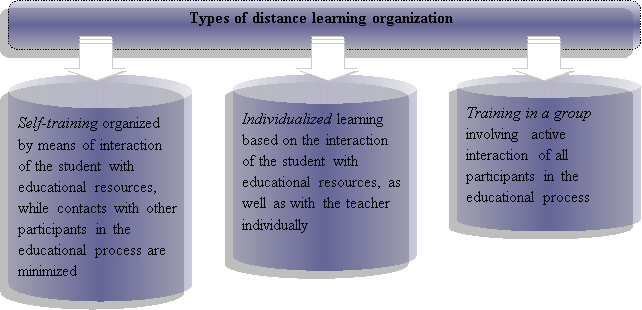The article discusses the classification of distance learning models, where the main quality of the model is its correspondence or similarity with the original system. The study of scientific material on this problem allowed the authors of the article to state that the characteristic features of the scientific model are simplicity and consistency, a certain ordered arrangement of its components, to some extent corresponding to the order and structure of the original system.
Keywords: model, technology, learning, students, process, grammar, classification.
В статье рассматривается классификация моделей дистанционного обучения, где основным качеством модели является ее соответствие или сходство с исходной системой. Изучение научного материала по данной проблеме позволило авторам статьи констатировать, что характерными чертами научной модели являются простота и непротиворечивость, определенное упорядоченное расположение ее компонентов, в некоторой степени соответствующее порядку и структуре исходной системы.
Ключевые слова: модель, технология, обучение, учащиеся, процесс, грамматика, классификация.
In the age of information technology, distance learning is gaining in popularity, which to some extent solves the existing problem. This form is characterized by flexibility regarding the time and place of organization of educational activities, makes education more open and accessible. In addition, the Internet is a huge data repository, which certainly increases the speed at which information is transmitted and received and thus has an impact on the quality of education. That is why, according to modern standards, educational institutions should integrate distance learning into education in order to increase its effectiveness [1].
The main objective of the introduction of e-learning in education is to ensure equal access of all participants in the educational process to better educational resources and technologies. And to achieve this goal, it is necessary to create conditions for the introduction of automation of the training process. Achievement of the goal improves the quality of training, efficiency of knowledge management, information interaction with the external environment.
In this connection, the main direction of informatization of the education system is the transition to a new educational strategy, based on highly effective technologies of development of society in accordance with the requirements of the XXI century.
Modern social and economic conditions demonstrate the failure of the principle of lifelong education and dictate the need to implement the concept of «lifelong education». Distance learning is the best solution to meet ever-changing educational needs. This approach enables the various members of society, regardless of their social status and place of residence, to receive quality education in the best educational institutions. In doing so, it is possible to take into account the individual characteristics and needs of students and to adapt the learning process to the temporary schedule of people combining study and work.
On the basis of the above material it is possible to conclude that it is necessary to use remote technologies in teaching English grammar to college students, which is reflected in the construction of its model.
Modern literature demonstrates a variety of approaches to the classification of distance learning models. The authors choose different bases for the classification. Moreover, in many of them the basis for the separation of models is not clearly expressed, resulting in one classification being models with different topics.
The earliest is the classification described in the monograph by T. P. Voronina, V. P. Kashitsyn, O. P. Molchanova [2]:
1) Traditional distance learning;
2) Open learning (development of distance learning using ICT);
3) Tele-education (use of audio, audio, audio, video and computer teleconferencing between teacher and learner, between learners);
4) Virtual classrooms and virtual universities (teleconferencing technologies, computer-based training programmes).
This approach, in our view, does not describe possible options for the organization of the learning process, but rather represents stages in the development of distance learning.
The models highlighted in the work of R. S. J. Tuninga and I. B. J. Seinen reflect the experience of foreign educational institutions in the organization of distance learning. The authors identify the following three models [3].
Advisory model. The basis of the learning process in this model is the regular attendance of students at a specialized counselling centre. In the center with students work specially trained teachers — tutors. They organize lectures, advise students, provide explanations and recommendations. Supervision of education is carried out by tutors on the basis of verification of homework and control tasks performed by pupils.
Model of correspondence (correspondence). A distinctive feature of this model is the absence of face-to-face contact of students with teachers. Training materials, assignments, questions are exchanged by mail or other communication channels such as telephone, fax, computer networks.
Model of adjustable self-learning. This model is characterized by a completely independent study of learning materials. The control of learning is also carried out by the student himself by performing tests.
Developer of didactic basics of distance learning A. A. Andreyev identifies five main models of organization of distance learning, with the means used for delivery and presentation of the teaching material [4].
Analyzing the classification of models proposed by E. S. Polat, it is possible to note the absence of a clear criterion for their allocation, but it is possible to trace two grounds for the classification: the features of the system of distance learning and the specificity of the educational process itself. The only classification with a strong model construction feature is that proposed by A. A. Andreev.
The models considered were developed more than ten years ago. Some of them are already outdated. In particular, today is not relevant model of correspondence training, it can be considered only as a stage in the development of distance learning. Radio and television models are very limited and can only be used in combination with other remote technologies.
In order to develop basic models of distance learning, it is necessary first of all to highlight the most important characteristics of distance learning — the topics that will form the basis of the classification. The learning model should characterize the learning process in a complex way: it should reflect the features of the process of interaction of participants in the learning process, the resources used, the ways to achieve results. We therefore consider it appropriate to base the classification on several attributes, i.e. multi-factor. In particular, we consider it appropriate to highlight two criteria that characterize the learning process:
- The means of telecommunication used to travel distances, ensure the delivery of educational material and communication of participants in the educational process;
- Type of communication between trainees and teachers.
The use of telecommunications has played a huge role in training. Each of them has its own specifics, affecting the possible ways and forms of interaction and imposing certain restrictions on the educational process. To date, a wide variety of distance education can be used to support the educational process: videoconferencing (exchange of video image that accompanies sound); Audio conferences (exchange of sound information on digital and analogue communications); Computer teleconferences; video lectures; live chat classes; web lessons; Radio communication; television channels.
Depending on the means of telecommunications used, three training options can be identified: case-based, web-based and mixed.
Depending on the way teachers and trainees communicate, there are three types of distance learning organization: Figure 1.
Each of these types of distance learning organization is characterized by a range of pedagogical methods and teaching methods that can be applied within the framework of this type of training.
Modeling as a research method assumes the presence of clear methodological and theoretical prerequisites, grounds. The model is an analogue, the deputy of the object under investigation.

Fig. 1. Types of distance learning organization
V. A. Stroff defines a model as a mentally represented system which, by displaying or reproducing the object of research, is able to replace it so that its study gives new information about the object. A model in pedagogy is a system created or chosen by the researcher, reproducing for the purpose of cognition the characteristics (components, elements, properties, parameters) of the object under study and therefore found with it in such respect substitutions or similarities, that her research serves as an indirect means of acquiring knowledge of the object and provides information that is unequivocally transformed into information about the object to be known and that allows experimental verification.
Thus, the main quality of the model is its correspondence or similarity to the original system. In this case, the model itself should be something single, holistic. Characteristic features of the scientific model are simplicity and consistency, a certain orderly arrangement of its components, to some extent corresponding to the order and structure of the original system.
References:
1. Law of the Republic of Kazakhstan. On Informatization. of 24 November 2015 418-V ZRC. https://adilet.zan.kz/rus/docs/Z1500000418/z150418.htm
2. Voronina T. P., Kashitsyn V. P., Molchanova O. P. Education in the era of NIT. M.: AMO, 1995. — p.220.
3. Tuninga R. S. J., Seinen I. B. J. The Supply and Demand of Distance Education in Russia / The World Bank, Bureau Cross, 1995. — 110р.
4. Andreev A. A., Soldatkin V. I. Distance Learning: Essence, Technology, Organization. M.: IESI Publishing House, 1999. — p.196







